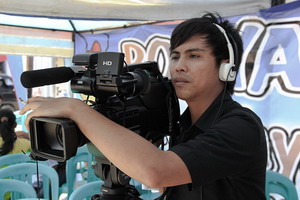 One of the challenges everyone has to face from time to time is dealing with fear. I have written many articles on the impact of stress on the body and our health. I don’t know if I have written about how to deal with the most common cause of stress, fear. Many other causes of stress, like poor diet, insufficient or too much exercise, poor posture, work ergonomics, bad shoes, and so on basically come down to making a corrective change that will relieve the stress on the body. But fear isn’t that simple. You can’t just go out and buy a new brain to fix the fear patterns in your present brain.
One of the challenges everyone has to face from time to time is dealing with fear. I have written many articles on the impact of stress on the body and our health. I don’t know if I have written about how to deal with the most common cause of stress, fear. Many other causes of stress, like poor diet, insufficient or too much exercise, poor posture, work ergonomics, bad shoes, and so on basically come down to making a corrective change that will relieve the stress on the body. But fear isn’t that simple. You can’t just go out and buy a new brain to fix the fear patterns in your present brain.
 Let’s start at the most basic level. When something threatens your immediate survival, fear switches on the adrenaline to give you the burst of energy needed to fight or run away. This greatly enhances your chances of survival. So in the right place and time, your fear reaction is a very good thing. As a species, we encounter this type of fear maybe 10% of the time relative to all our other fear responses. In my neighborhood, this is probably really happening almost never. In other parts of the world, immediate survival can be a daily ordeal. When it is needed, it is a powerful tool. This is not the fear the rest of this article will discuss.
Let’s start at the most basic level. When something threatens your immediate survival, fear switches on the adrenaline to give you the burst of energy needed to fight or run away. This greatly enhances your chances of survival. So in the right place and time, your fear reaction is a very good thing. As a species, we encounter this type of fear maybe 10% of the time relative to all our other fear responses. In my neighborhood, this is probably really happening almost never. In other parts of the world, immediate survival can be a daily ordeal. When it is needed, it is a powerful tool. This is not the fear the rest of this article will discuss.
 The next level up for fear is a highly developed group warning behavior many species have. Group cooperation for enhancing survival is our ability to broadcast anxiety through posture and vocal expressions. This is an example of how this works— A group of people is hunting or traveling in the open. If one individual encounters a threat, their posture and voice communicate the presence of the threat to the rest of the group. We see this in large gatherings of people. Fear can travel through a crowd in an instant. This happens faster than vocal expressions of warning can trigger. We will react to postures of threat or fear in people way before they get close enough for us to hear them. This produces an early warning system to enhance the survival of the group even though the first person to encounter the threat may not survive.
The next level up for fear is a highly developed group warning behavior many species have. Group cooperation for enhancing survival is our ability to broadcast anxiety through posture and vocal expressions. This is an example of how this works— A group of people is hunting or traveling in the open. If one individual encounters a threat, their posture and voice communicate the presence of the threat to the rest of the group. We see this in large gatherings of people. Fear can travel through a crowd in an instant. This happens faster than vocal expressions of warning can trigger. We will react to postures of threat or fear in people way before they get close enough for us to hear them. This produces an early warning system to enhance the survival of the group even though the first person to encounter the threat may not survive.
 This is all well and good when the threat is real. What happens when the threat is not immediate or real? A powerful example of this happened last year at a Halloween party in Korea. A wave of fear triggered a mass stampede out of the party venue that left 153 people trampled to death. This is a massive example of something that happens on a small scale every day around us. Someone you don’t even know at the grocery store could be in a lot of fear for reasons that have nothing to do with here and now. You don’t consciously recognize the fear triggers they are putting out, but your body does. You end up in a stress reaction without even knowing why. What usually happens, since we are not generally at our best when we are in fear, is we will create some negative participation with someone which we can then blame our stress on. So often we are in stress before we even know it. We then pass it on to the next person and we all go down together. The last three years have been a classic example of this. We have had a pandemic of fear more than anything else.
This is all well and good when the threat is real. What happens when the threat is not immediate or real? A powerful example of this happened last year at a Halloween party in Korea. A wave of fear triggered a mass stampede out of the party venue that left 153 people trampled to death. This is a massive example of something that happens on a small scale every day around us. Someone you don’t even know at the grocery store could be in a lot of fear for reasons that have nothing to do with here and now. You don’t consciously recognize the fear triggers they are putting out, but your body does. You end up in a stress reaction without even knowing why. What usually happens, since we are not generally at our best when we are in fear, is we will create some negative participation with someone which we can then blame our stress on. So often we are in stress before we even know it. We then pass it on to the next person and we all go down together. The last three years have been a classic example of this. We have had a pandemic of fear more than anything else.
 Fear is useful for immediate threats. It is to propel us into immediate action. So the first thing we want to do when we feel this fear is to check in around ourselves. Is there any immediate threat? A reality check is really important, but it requires us to be able to feel and acknowledge our feelings. Many of us have been so inundated with fear and anxiety that we have learned to shut out those feelings. The problem is our body is still reacting even though we have shut them out of our conscious awareness. Blocking our feelings fails our health terribly. We need a better strategy. I suggest you feel everything and assess what needs to be acted on and want does not. It takes more work than popping a pill, taking a drink, or lighting up, and the outcome is much more effective on many levels.
Fear is useful for immediate threats. It is to propel us into immediate action. So the first thing we want to do when we feel this fear is to check in around ourselves. Is there any immediate threat? A reality check is really important, but it requires us to be able to feel and acknowledge our feelings. Many of us have been so inundated with fear and anxiety that we have learned to shut out those feelings. The problem is our body is still reacting even though we have shut them out of our conscious awareness. Blocking our feelings fails our health terribly. We need a better strategy. I suggest you feel everything and assess what needs to be acted on and want does not. It takes more work than popping a pill, taking a drink, or lighting up, and the outcome is much more effective on many levels.
 Fear tactic #1: Feel your feelings and assess any need for action. Frequently, when you trace the feelings back to when you first felt them, you will find that they are not even your feelings. You simply reacted to another person’s feelings.
Fear tactic #1: Feel your feelings and assess any need for action. Frequently, when you trace the feelings back to when you first felt them, you will find that they are not even your feelings. You simply reacted to another person’s feelings.
 Very rarely in our modern society do we have immediate threats to our survival. The evening news would like us to believe that death lurks around every corner, but it simply is not true. They are using the threat voicing technique to grab our attention. Their paycheck comes from holding our attention so they use anything that works. Warnings and anxiety-inducing stories keep them in business, not realistic and reasoned reporting of the facts. That is why I have not watched broadcast news in 30 years. This is part of reducing the background noise that induces unnecessary fear, and along with it unnecessary stress in my body.
Very rarely in our modern society do we have immediate threats to our survival. The evening news would like us to believe that death lurks around every corner, but it simply is not true. They are using the threat voicing technique to grab our attention. Their paycheck comes from holding our attention so they use anything that works. Warnings and anxiety-inducing stories keep them in business, not realistic and reasoned reporting of the facts. That is why I have not watched broadcast news in 30 years. This is part of reducing the background noise that induces unnecessary fear, and along with it unnecessary stress in my body.
 This reaction we have to the sound of anxiety in another person’s voice is a built-in caring response we have towards such sounds in babies and children. They frequently go into fear simply because they don’t know what to do with some situation they are facing. They have not had the experiences necessary to teach them options for action to resolve their discomfort of the moment. So, they cry out hoping to get our attention. A good parent will not only comfort them but also provide them with skills for handling the situation themselves in the future. I often find that one of the biggest triggers for fear is not knowing what to do with some looming situation. This is more the worry type of fear, but it still is a bugger. When you have a preset and practiced action plan for dealing with some difficulty, the fear is little more than getting up the energy to move into action. When you have no idea what to do with some situations, the mind tends to go into that most useless response, freeze. This really plays havoc with our physiology. It is like how those drag racers start out spinning their wheels but have their front brakes on at the same time. They are literally melting their back tires as they spin. We do that internally with our hormones and nervous system when we go into freeze mode. If you get stuck in one of these, do something, anything to get back into action.
This reaction we have to the sound of anxiety in another person’s voice is a built-in caring response we have towards such sounds in babies and children. They frequently go into fear simply because they don’t know what to do with some situation they are facing. They have not had the experiences necessary to teach them options for action to resolve their discomfort of the moment. So, they cry out hoping to get our attention. A good parent will not only comfort them but also provide them with skills for handling the situation themselves in the future. I often find that one of the biggest triggers for fear is not knowing what to do with some looming situation. This is more the worry type of fear, but it still is a bugger. When you have a preset and practiced action plan for dealing with some difficulty, the fear is little more than getting up the energy to move into action. When you have no idea what to do with some situations, the mind tends to go into that most useless response, freeze. This really plays havoc with our physiology. It is like how those drag racers start out spinning their wheels but have their front brakes on at the same time. They are literally melting their back tires as they spin. We do that internally with our hormones and nervous system when we go into freeze mode. If you get stuck in one of these, do something, anything to get back into action.
 A study that was published recently on the most effective stress reduction intervention concluded that cyclic breathing was the most effective approach – better than mindfulness meditation, box breathing, and several others. This is super simple. Your nervous system goes into relaxation mode as you exhale. So cyclic breathing is about spending more time exhaling than inhaling – 3X more. So, inhale sharply for 2 seconds then exhale slowly for the next 6 seconds. Just keep this up as you relax. Other research has shown that simply walking in nature does wonders for reducing stress. Even where your eyes are focused can affect this. Focusing on objects within a few feet of you increases stress while focusing your vision on objects in the distance relaxes you. Similarly, keeping your head pointed at a screen instead of moving back and forth and scanning the environment also increases stress.
A study that was published recently on the most effective stress reduction intervention concluded that cyclic breathing was the most effective approach – better than mindfulness meditation, box breathing, and several others. This is super simple. Your nervous system goes into relaxation mode as you exhale. So cyclic breathing is about spending more time exhaling than inhaling – 3X more. So, inhale sharply for 2 seconds then exhale slowly for the next 6 seconds. Just keep this up as you relax. Other research has shown that simply walking in nature does wonders for reducing stress. Even where your eyes are focused can affect this. Focusing on objects within a few feet of you increases stress while focusing your vision on objects in the distance relaxes you. Similarly, keeping your head pointed at a screen instead of moving back and forth and scanning the environment also increases stress.

Fear tactic #2: Take action – cyclic breathing, walking in nature, and visual scanning can all be used to break out of freeze mode.
 The last piece for today is using your ability to tap into resources beyond your conscious mind for dealing with fearful situations. As I mentioned before, a major source of fear is not knowing what to do. Most of the time these days immediate action is rarely demanded from us. We can stall and delay most things in some way. Our conscious mind is only 5% to 10% of who we are. We have access to vast resources of creative intelligence if we choose to learn how to use it. Our brain does this automatically every night. This is part of what happens while we dream each night. The world of science is littered with stories of researchers confounded by some problem only to awaken after a night’s sleep with the answer floating in their minds. The magic key to this superpower is expectancy. Other people will call this faith.
The last piece for today is using your ability to tap into resources beyond your conscious mind for dealing with fearful situations. As I mentioned before, a major source of fear is not knowing what to do. Most of the time these days immediate action is rarely demanded from us. We can stall and delay most things in some way. Our conscious mind is only 5% to 10% of who we are. We have access to vast resources of creative intelligence if we choose to learn how to use it. Our brain does this automatically every night. This is part of what happens while we dream each night. The world of science is littered with stories of researchers confounded by some problem only to awaken after a night’s sleep with the answer floating in their minds. The magic key to this superpower is expectancy. Other people will call this faith.
 Simply ask to be shown an answer to whatever is troubling you with the full expectation that you will be shown the answer that is right for you. UNDERSTAND THAT YOUR WAY IS ONLY FOR YOU, NO ONE ELSE. Another key to using this ability is owning that you are responsible for doing whatever needs to be done. Any answers you get will be based on who you are and what you can do personally. Phrase your requests as positive statements or questions. The subconscious mind does not understand words like not, don’t, and can’t as it thinks in pictures and feelings, not words. Your answer may come as a feeling, as words whispered in your head, as a lesson from watching a movie or from a book. Sometimes you can just ask a friend what they would do and it might spark an answer for you. The idea is our answers are all around us. We have to polarize ourselves to receive them by asking for the answers.
Simply ask to be shown an answer to whatever is troubling you with the full expectation that you will be shown the answer that is right for you. UNDERSTAND THAT YOUR WAY IS ONLY FOR YOU, NO ONE ELSE. Another key to using this ability is owning that you are responsible for doing whatever needs to be done. Any answers you get will be based on who you are and what you can do personally. Phrase your requests as positive statements or questions. The subconscious mind does not understand words like not, don’t, and can’t as it thinks in pictures and feelings, not words. Your answer may come as a feeling, as words whispered in your head, as a lesson from watching a movie or from a book. Sometimes you can just ask a friend what they would do and it might spark an answer for you. The idea is our answers are all around us. We have to polarize ourselves to receive them by asking for the answers.
 Fear tactic #3: Just ask then act. Accept that we are not all-knowing. We need help and guidance. It is okay to ask for this.
Fear tactic #3: Just ask then act. Accept that we are not all-knowing. We need help and guidance. It is okay to ask for this.
Fear is the mind-killer. It kills the body as well, just more slowly. There are ways to tame fear. Embrace and accept your relationship with

whatever is causing you to fear. Changing that relationship is what takes you out of the fear.
Take care,
David
